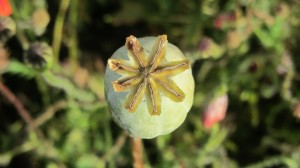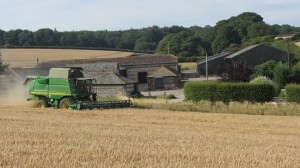 The cropping season we all want to forget is over, hopefully never to be repeated, records have been broken, the wrong kind, the weather as always has had the last laugh, and as I write is giving the north a good soaking again.
The cropping season we all want to forget is over, hopefully never to be repeated, records have been broken, the wrong kind, the weather as always has had the last laugh, and as I write is giving the north a good soaking again. 
Last week we sent away the first load of poppy for processing, weaned the lambs, prepared some more stale seedbeds and managed to spray all the newly emerged oilseed rape for grass weeds. 
The rape has been in the ground for nearly 3 weeks now, and has all emerged well, the recent rain will help it on its way, although may attract slugs back to the surface so we will have to watch out for their tell-tale munch marks. Straight after sowing we applied the main dose of weedkiller, pre-emergence is usually the most effective, to control the most competitive weeds, such as meadowgrass, chickweed, speedwells and cleavers. The requirements for effective weedkiller application are quite exacting, here is an exerpt from the label on the can:
With drilled crops, when applying Butisan S pre-emergence, it is important for crop safety to ensure physical separation of the herbicide from the seed. This is achieved by ensuring that the seed is well covered with soil, to a depth of 15 mm. With direct drilled crops, harrow across slits to cover the seed before spraying Butisan S.
Loose and puffy seedbeds must be consolidated before treatment.
A reduction in crop vigour, weed control and possibly plant stand may occur with excessive rainfall shortly after application. Where a crop check has occurred this usually grows out after a few weeks and yields are normally unaffected.
Do not apply Butisan S to soils with a compaction layer or to poorly drained soils, since damage can occur under waterlogged conditions.
If Butisan S is applied onto a dry soil surface it will only be effective after rainfall has occurred. Light (10 mm at any one time) irrigation will help to ensure herbicidal activity. Weed control is dependent on adequate moisture.
On brashy and stony soils, Butisan S may cause some reduction in crop vigour and/or plant stand, due to the chemical moving down to the rooting zone too rapidly.
Do not overlap spray swaths, particularly on the headlands
Ok, so not too shallow, and not too deep either, or the little shoot won’t make it to the surface, not too fluffy, not too dry or it won’t work, and not too wet either, or it may kill the crop, no stones, overlaps, compaction or waterlogging.
Got all that? I get the impression the chemical company are covering their backs in the event of trouble, it’s a bit like all the warnings written on drugs for human consumption. If you read them all you’d never take another pill in your life.
Once we have laid out quite an investment already on the seed, the spray, some fertiliser and the work required to do all this, the last thing we want is for the slugs to come along and eat the plants as they are emerging, and because this summer has been so slug friendly, and some of the newly sown rape fields suffered complete crop failure last time they were in rape four years ago, we were taking no chances, so a light sprinkling of slug pellets was applied as well, then we crossed our fingers and waited. 
Phew, this is how it looked last week. There was also a lot of fast growing barley and some sterile brome threatening to swam the rape in some areas, so out with the sprayer we had to go again. Luckily Friday was calm and the job was completed before the deluge on Sunday.
On the subject of slugs, has anyone tried creeping out into the garden after dark with a torch, a bucket and a salt cellar? Go and see what you can find on a damp evening, you may get quite a surprise.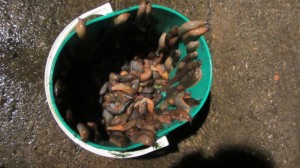
One householder in Shillingstone is reputed to have picked up over 400 of these slimy devils in their garden in one evening. I met a lady last week who stalks around her garden with a pointed stick, I’ll let you imagine what she does with it.
Before we move on completely from this year’s harvest, there were plenty of enjoyable moments when we weren’t thinking about how little wheat there was coming in from each field, or how dreadful the shrivelled grain looked. Getting on with the work on a sunny day has its rewards, getting the old baler out for example, to make just 200 small bales, is a bit of fun, just to remind ourselves what real work was like. 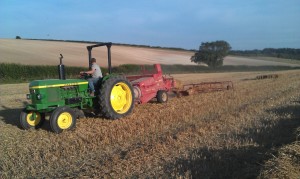 30 to 40 years ago we would make and haul 10,000 of these every summer, and another 10,000 hay bales, that was when men were men, and I was still a schoolboy. These days the cattle are fed and bedded on round bales of silage and straw, which are all moved by machines.
30 to 40 years ago we would make and haul 10,000 of these every summer, and another 10,000 hay bales, that was when men were men, and I was still a schoolboy. These days the cattle are fed and bedded on round bales of silage and straw, which are all moved by machines.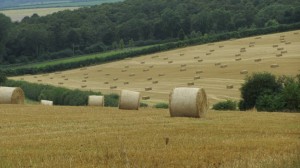
The answer to last month’s question about how to cure a broody hen is simply to give it a dunking in a bucket of water! It works brilliantly.
Harvest 2012 will be remembered as a damp end to a terribly wet summer, but already we are well into crop 2013, the rape is all sown, and with luck later this week we will start sowing the wheat for next summer’s harvest.

